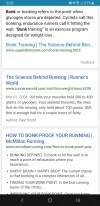Barobins
Member
- Time of past OR future Camino
- Francés fall/winter 2019
Hi all,
I am having some issues during training with getting hungry often while walking. I’m using a lot of bars, and fruit, but I’m thinking I might need to add something to my water. Sometimes it’s just hard to keep eating bars too!
There are a million electrolyte drinks here in the US...what is available in Spain?
What do any of you use to keep up your blood sugar?
I’m 5’2’ (157 cm) and 59 kilos. I don’t really have any body weight agenda...I just don’t want to “bonk”!
Any info would be great!
I’m doing the CF from Pamplona 21 Oct.
Thanks!
Barbara
I am having some issues during training with getting hungry often while walking. I’m using a lot of bars, and fruit, but I’m thinking I might need to add something to my water. Sometimes it’s just hard to keep eating bars too!
There are a million electrolyte drinks here in the US...what is available in Spain?
What do any of you use to keep up your blood sugar?
I’m 5’2’ (157 cm) and 59 kilos. I don’t really have any body weight agenda...I just don’t want to “bonk”!
Any info would be great!
I’m doing the CF from Pamplona 21 Oct.
Thanks!
Barbara




















